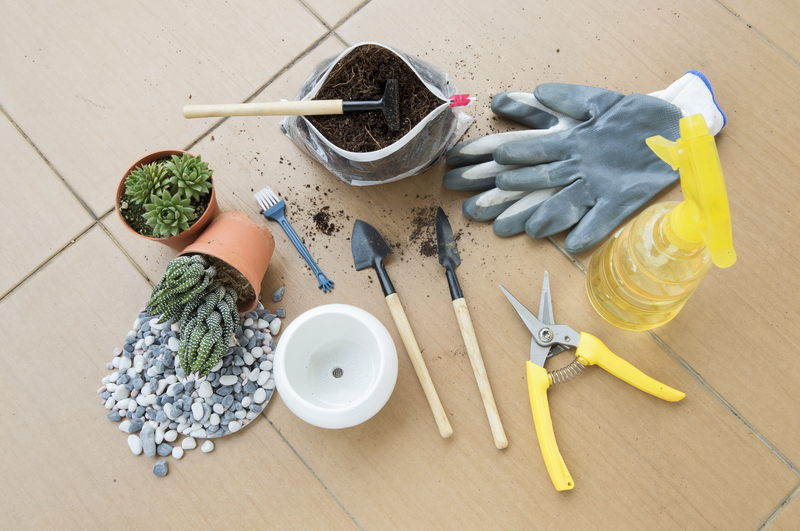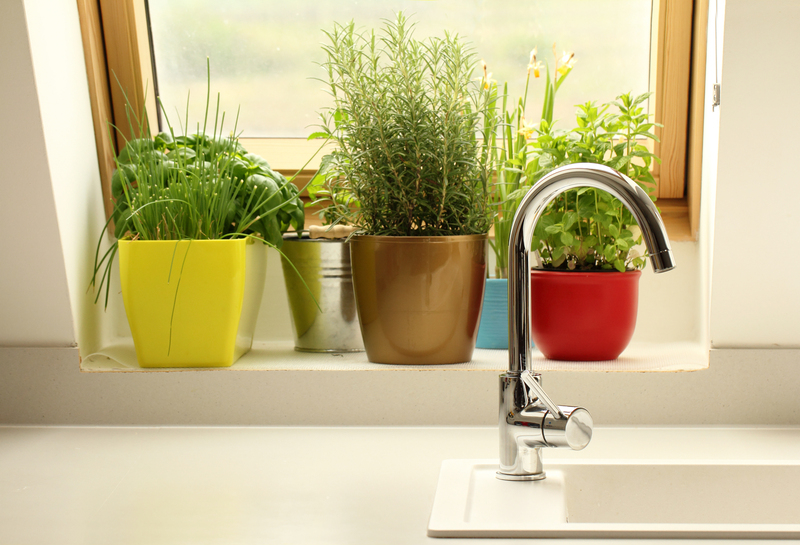Nurturing a Flourishing Herb Garden with Ease
Posted on 11/09/2025
Nurturing a Flourishing Herb Garden with Ease
Herb gardening offers a wealth of benefits--from adding fresh flavors to your culinary creations, uplifting your landscape, purifying indoor air, to even providing herbal remedies. Whether you have a small windowsill or a sprawling backyard, cultivating a thriving herb garden can be both satisfying and simple if approached with the right knowledge. In this comprehensive guide, we'll walk you through the essentials of nurturing a flourishing herb garden with ease, offering expert tips and actionable advice to set you on the path to herb-growing success.
Why Grow Your Own Herb Garden?
There are several compelling reasons to start your own herb garden:
- Fresh Flavors: Nothing beats the taste of freshly picked herbs in your meals.
- Cost-Effective: Growing herbs saves money compared to buying them at the grocery store.
- Therapeutic Value: Gardening reduces stress and enhances well-being.
- Decorative Appeal: Herbs enliven your home with greenery and fragrance.
- Eco-Friendly: Homegrown herbs reduce packaging waste and carbon footprint.
As you'll discover, starting and caring for a robust herb garden isn't as difficult as you might think. Let's begin with the basics!

Choosing the Right Herbs for Your Garden
The first step in nurturing a prolific herb garden is selecting herbs suited to your region and tastes. Consider these factors:
- Climate & Location: Some herbs, like rosemary and thyme, prefer warm, sunny conditions. Others, such as mint and cilantro, tolerate some shade and cooler climates.
- Usage: Will you primarily be using herbs for cooking, teas, medicinal remedies, or aromatic purposes?
- Growth Habits: Vigorous growers like mint can overwhelm other herbs unless contained, so plan accordingly.
Best Herbs for Beginners
- Basil: Thrives in sun and adds a delicious punch to many dishes.
- Parsley: Versatile and hardy, grows well in pots or garden beds.
- Mint: Exceptionally robust, great for teas and cocktails; container growing recommended.
- Chives: Almost foolproof and provides a fresh, onion-like flavor.
- Rosemary: Fragrant and drought-tolerant once established.
- Thyme: Compact and ideal for container or border planting.
- Cilantro: Prefers cooler temperatures; perfect for salsas and garnishes.
Start with a few favorites and expand as you gain confidence and experience.
Planning and Positioning Your Herb Garden
When it comes to herb gardening made easy, proper planning is crucial. Here are key considerations to ensure strong plant growth:
- Sunlight: Most herbs require at least 6 hours of sunlight daily. Observe your chosen location throughout the day to find the sunniest spot.
- Soil: Herbs prefer well-drained, slightly alkaline to neutral soil. Consider raised beds or containers if your native soil is heavy clay or sandy.
- Irrigation: Ensure herbs receive consistent, moderate moisture. Avoid waterlogging, which causes root rot.
- Air Circulation: Good airflow around plants reduces risk of fungal diseases.
Designing Your Herb Layout
- Group herbs by watering needs. For instance, Mediterranean herbs like rosemary, sage, and thyme prefer drier conditions and can be planted together.
- Arrange by height. Place taller herbs like dill and fennel at the back, medium height in the middle, and low-growing varieties such as thyme and oregano at the front.
- Allow space for spread. Herbs like mint and oregano can sprawl, so provide ample room or plant in pots.
- Incorporate herbs into ornamental beds. Many herbs offer attractive foliage and flowers that complement garden aesthetics.
Setting Up Your Herb Garden
In-Ground Planting
If you have garden space, create well-defined beds enriched with organic matter. Perform a soil test and adjust pH, if necessary, to achieve a level between 6.0 and 7.5.
- Amend soil with compost or aged manure for improved fertility and texture.
- Plant herbs with adequate spacing to ensure airflow and minimize competition.
- Mulch between plants to retain moisture and impede weed growth.
Container Herb Gardening
No garden plot? No problem! Container herb gardens are ideal for balconies, patios, or even windowsills.
- Select pots with ample drainage holes to prevent soggy roots.
- Use quality potting mix that encourages good drainage and includes nutrients.
- Group herbs with similar water and sun needs in larger containers, or give each plant its own pot to prevent overcrowding.
Proper Planting: Seeds vs. Starters
While herbs can be grown from seeds or starter plants, each method has its pros and cons:
- Seeds: Most affordable option and allows you to try rare varieties. However, some herbs can be slow or erratic to sprout.
- Starters (Transplants): Faster route to harvest, especially for beginners. Higher cost but more reliable success rates.
Herbs like basil, cilantro, and dill can be direct seeded once frost passes, while slow-growers like rosemary and thyme often do better with transplants.
Watering Tips for Thriving Herbs
One of the secrets to maintaining a healthy herb garden with ease is proper watering practice:
- Water deeply and less often: Shallow, frequent watering encourages weak, shallow roots. Provide a thorough soak when the soil feels dry an inch below the surface.
- Morning is optimal: Watering in the early morning minimizes evaporation and reduces disease risk.
- Avoid wetting the foliage: Excess moisture on leaves can promote fungal diseases.
- Monitor container gardens closely: Pots dry out faster than ground beds, especially in hot weather.
Fertilizing and Feeding Your Herbs
While herbs are generally undemanding, occasional feeding helps boost growth--especially in poor soils and containers. Here's how to do it right:
- Go light on the fertilizer: Over-fertilizing can make herbs less flavorful (e.g., basil, oregano).
- Use organic options: Diluted fish emulsion, compost tea, or slow-release organic fertilizers work wonders.
- Monthly feedings in containers: Pot-grown herbs benefit from feeding every 4-6 weeks during active growth.
Pruning, Harvesting, and Maintaining Healthy Herbs
The Art of Pruning
- Pinch back regularly: Frequent pinching of tips encourages bushier growth and delays flowering (bolting).
- Remove flowers quickly: Unless you're saving seeds, keep herbs from flowering to preserve their flavor.
- Harvest often: Use clean, sharp scissors or pruners to cut stems above a pair of healthy leaves.
Dealing with Pests and Diseases
Herbs are relatively pest-resistant, thanks to their aromatic oils, but problems can arise. Keep your herb garden flourishing with these tips:
- Promote biodiversity: Interplant a variety of herbs and flowers to attract beneficial insects.
- Hand-pick pests: Remove caterpillars, aphids, or beetles manually when possible.
- Use gentle controls: Avoid harsh chemicals. Try neem oil, insecticidal soap, or homemade garlic/chili sprays.
- Practice crop rotation: Rotate annual herbs to fresh soil each year to reduce disease risk.
Stay watchful for signs of trouble, and act promptly for best results!
Winter Care and Year-Round Harvest
- Bring tender herbs indoors: Basil, lemongrass, and rosemary can overwinter indoors near a sunny window.
- Mulch perennials: Protect the roots of lavender, thyme, and sage in cold climates with a thick layer of mulch.
- Start new seeds late winter: Plan ahead for transplants to set out with spring.
Maximizing Yield: Companion Planting and Succession Sowing
Companion planting enhances growth, aroma, and insect resistance. Pair basil with tomatoes, plant dill with cabbage, or use chives near roses to deter pests. Consider:
- Succession sowing: Stagger plantings of fast-growing herbs (like cilantro and dill) every 2-3 weeks for a continuous harvest.
- Interplant herbs and vegetables: Save space and boost yields by growing herbs among vegetables.
Harvesting and Using Your Fresh Herbs
The beauty of maintaining an abundant herb garden is in the harvest! Follow these guidelines for best flavor and longevity:
- Harvest in the morning: Essential oils are most concentrated after the dew dries.
- Pick young, tender leaves: Older, woody stems can be tough and less flavorful.
- Store properly: Place stems in water like a bouquet for short-term use, or refrigerate in damp paper towels.
- Dry or freeze surplus: Preserve excess harvest for off-season use by air drying, oven drying, or freezing in ice cube trays.

Frequently Asked Questions About Herb Gardening
Can you grow herbs indoors?
Absolutely! Many herbs flourish indoors provided they get at least 6 hours of sunlight daily, ideally from a south-facing window. Supplement with a grow light if needed.
What are the easiest herbs to grow for beginners?
Chives, mint, basil, and parsley are some of the easiest and most forgiving for novice gardeners.
How often should you water herb gardens?
Water only when the top inch of soil feels dry. Herbs dislike soggy conditions but need consistent moisture, especially when grown in containers or during hot weather.
How do I stop herbs from flowering (bolting)?
Pinch back growing tips frequently and harvest early to delay flowering, which usually makes leaves taste bitter.
Final Thoughts: Create Your Dream Herb Garden--with Ease!
Nurturing a thriving herb garden with ease is within anyone's reach with the right approach. Start small, select herbs you love to use, and experiment with different varieties and planting styles. Whether on a windowsill or a lush outdoor plot, your herb gardening adventure will reward you with fresh flavors, natural beauty, and the satisfaction of growing your own harvest.
Are you ready to transform your home with the magic of herbs? Follow the easy steps above to cultivate a flourishing, resilient, and beautiful herb garden that brings joy and abundance through every season!

